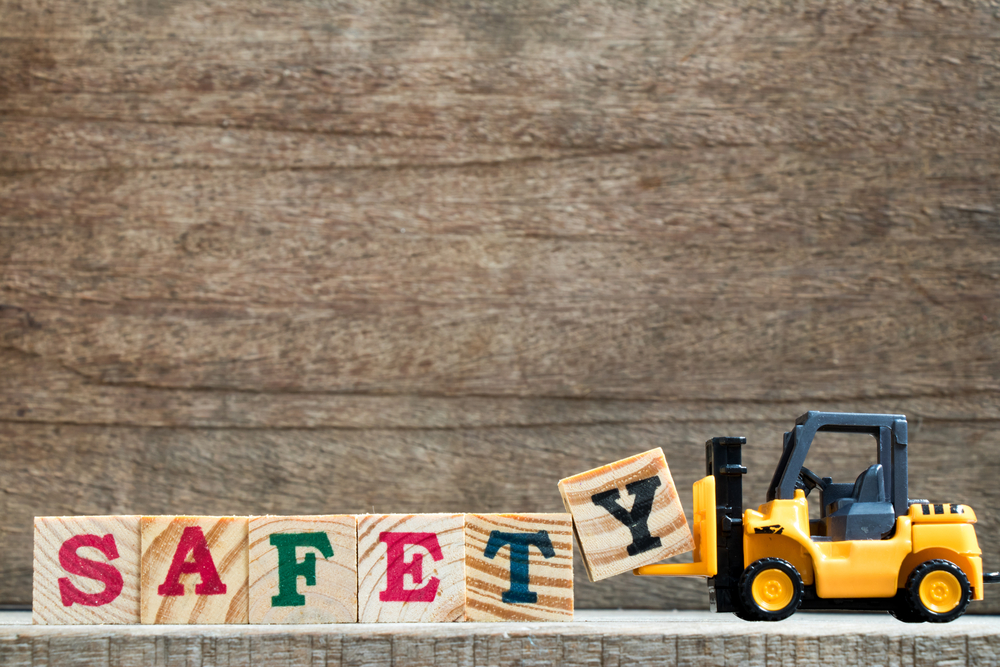Essential Forklift Safety Tips
Your business requires its workers to use a forklift to raise and lower heavy loads. To ensure your workers can operate this machine correctly, it pays to teach them forklift safety tips. That way, your employees can use a forklift without causing an accident that leads to an injury or fatality.
10 Can’t-Miss Forklift Safety Tips You Need to Share with Your Employees
Share the following forklift safety tips with your workers, and they’ll be well-equipped to avoid accidents.
1. Inspect a Forklift Before a Work Shift
Perform an inspection before a forklift is used. The inspection gives an operator an opportunity to identify any issues that can otherwise hamper the machine’s performance.
Workers should follow OSHA forklift inspection requirements. They can assess a forklift’s fluid levels, finger guards, and other lift components during a pre-start inspection. Also, they must perform an operational inspection to ensure a lift’s brakes, steering, and other functional components are working correctly.
If a forklift operator identifies any problems during an inspection, he or she should notify their manager immediately. The lift must then be taken out of service until it is repaired.
2. Perform Regular Maintenance
Forklifts must be properly maintained according to the manufacturer’s instructions.
OSHA requires businesses to develop and follow a regular forklift maintenance schedule. It offers a guide that companies can use to create, manage, and update their forklift maintenance schedule.
3. Operate a Forklift at a Safe Speed
Forklift operators need to drive their lift at a safe speed. They must be careful when rounding corners and approaching blind spots. And, they should always wear proper safety clothing and equipment.
Furthermore, businesses can set up speed limit signs at worksites. They can regularly remind forklift operators to drive carefully and follow posted warning signs.
4. Ensure the Forks Are Low to the Ground
A forklift operator must keep the forks low to the ground. This helps the operator maintain clear forward visibility.
There may be times when a forklift operator keeps the forks low to the ground but their load hampers their ability to safely move their lift forward. In these instances the operator should drive their lift in reverse.
Regardless of the direction of travel, a forklift operator must maintain 360° visibility around their lift. The operator should always keep their eyes on the direction of travel and use their rear-view mirrors. He or she can also activate their lift’s headlights to maintain clear visibility at night or outdoors.
5. Keep the Forklift Load Stable
When handling loads, forklift operators must be aware of off-center loads, overloading, and damaged or loose loads. Operators need to be careful when approaching loads, using the proper mast position, and the fork position.
There is no need to overload a forklift, either. Doing so can cause a lift to tip over. So, forklift operators must know a lift’s weight capacity and avoid exceeding it.
6. Use Floor Markers
Install floor markers to boost workplace safety. The markers can warn forklift operators about on-the-job hazards. They can be used to keep pedestrians away from forklift paths as well.
7. Follow the Forklift’s Load Capacity
Confirm a forklift’s load capacity and ensure it is never exceeded. Otherwise, overloading a lift can lead to a tip-over, along with property and equipment damage. Even worse, the tip-over can cause a serious injury or fatality.
8. Do Not Carry Extra People on a Forklift
Forklifts are designed to carry loads, not extra people. Thus, a forklift operator should never use their lift for any reason outside of its intended purpose. If a forklift is required to raise a worker, it should only be used in combination with a secure work platform and cage.
9. Keep the Forklift a Safe Distance from Bystanders and Other Machinery
A forklift should be operated away from bystanders and heavy machinery whenever possible. Operators should ensure they have sufficient room to be able to stop their lift without the risk of striking a bystander or other machinery.
10. Require Your Workers to Stay Up to Date on Forklift Safety Tips
Verify that all forklift operators earn OSHA-approved certification. They must receive recertification every three years. With recertification, operators can receive the most up-to-date OSHA forklift safety tips.

Why Should You Share Forklift Safety Tips with Your Workers?
Even at low speeds, a forklift is capable of inflicting damage or causing a serious injury or even death. Simple measures like wearing seat belts, observing stop signs and speed limits, and sounding a horn approaching blind spots can go a long way toward maintaining a safe working environment. Other measures, like keeping the hands and feet contained within the overhead guard of the forklift and remaining inside the truck in the event of a tip-over are less obvious. This is why it’s essential to share safety tips for forklifts with your workers and take workplace safety seriously.
Why Do Forklift Accidents Occur?
Every three days, someone in the United States dies as the result of a forklift accident. Yet, many forklift accidents can be avoided if drivers receive proper training.
Forklift accidents can occur at any time, without notice. There are many factors in a workplace that can increase the chance of accidents occurring.
The main causes of forklift fatalities are:
- Forklift Tip-Over: Forklifts are notoriously unstable, especially when they are used to carry a load. A forklift should be driven with the load tilted back and no more than 6- to 8-in. off the ground. If an operator is driving a sit-down forklift that starts to overturn, he or she should ignore their instinct to jump off and get out of the way. At this point, the operator should stay with the truck, hold on tight, and lean the other way.
- Pedestrian Struck by a Forklift: Pedestrians and forklifts should be kept far apart from one another. Every effort should be made to alert pedestrians when a forklift is nearby. In fact, an operator can use the horn, flashing lights, and back-up alarms to ensure pedestrians are aware that a forklift is nearby.
- Driver Falls from a Forklift: A forklift operator can inadvertently travel on an uneven surface, which can lead to a fall. Or, he or she can drive too fast and travel too quickly around a corner, resulting in a fall. To avoid falling from a forklift, an operator should always wear their seat belt and never carry passengers.
Other factors that can lead to both forklift accidents include:
- Lack of Operator Training: Workers who do not have their forklift certification are ill-prepared to recognize hazards that can cause accidents. They are more likely than other employees to be involved in an accident.
- Driving Forklifts at High Speeds: Drivers often cannot brake in time to avoid other workers and vehicles. Speeding can also cause tip-overs and collisions.
- Lack of Proper Tools: Operating a forklift without the right tools, attachments, and accessories can make it difficult for drivers to respond to emergencies.
- Poor Forklift Maintenance: Not checking forklifts each day for any signs of wear and tear and failing to perform regular maintenance and repairs can lead to operational issues and accidents.
Certification training provides workers with forklift safety tips they can use to quickly identify and address on-the-job hazards. The training even provides tips that can help workers stop lift accidents, injuries, and fatalities.
Why Are OSHA Reach Truck Safety Tips Important?
OSHA offers reach truck safety tips to protect businesses and their employees. Companies can share these tips with their forklift operators. In doing so, they can help these operators guard against lift accidents.
There is no guarantee that reach truck safety tips will prevent forklift accidents. However, these tips have been shown to help forklift operators limit the impact of accidents. In some instances, they have helped operators prevent forklift accidents.
What Are the Benefits of Sharing OSHA Forklift Safety Tips with Your Employees?
Forklift safety should be a priority for any company that requires its workers to use lifts. Workers who learn OSHA forklift safety tips can protect themselves and others against accidents, injuries, and fatalities. Plus, they can safely complete work tasks and become more productive and efficient than ever before.
Along with these benefits, employers won’t have to worry about OSHA compliance penalties if their workers earn forklift certification. As such, employers can provide their workers with OSHA-compliant forklift certification training that benefits both parties.
The bottom line: a properly trained forklift operator can be a difference-maker in terms of workplace safety. He or she knows how to operate a forklift safely, thanks to proper training through a recognized and OSHA-compliant program.
Why Should You Provide Your Workers with Forklift Safety Training?
The aforementioned forklift safety tips are for guidance only and are not intended to substitute for proper OSHA-compliant training. While forklift fatalities are approaching record lows, employers should still make sure their workers have a proper certification and the common sense to be safe.
Want to Provide OSHA-Approved Forklift Certification Training to Your Workers? Partner with CertifyMe.net
According to OSHA, all forklift operators must have forklift training to properly operate the equipment and be safe on the job. The forklift training from CertifyMe.net covers all the requirements set by OSHA, including all necessary topics to equip workers with everything they need to drive forklifts safely.
Our online course can be accessed from any device with an internet connection, and completed in only about one hour. Once workers have completed their training, they will be 100% OSHA-compliant and equipped with all the most important forklift safety tips. To learn more about our forklift safety certification training program, please contact us online or call us today at 1-888-699-4800.

